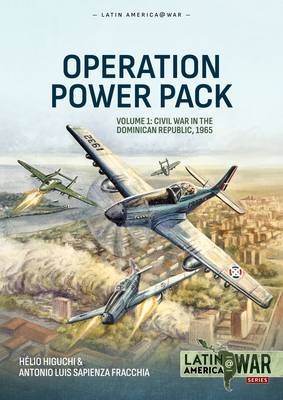
- Retrait en 2 heures
- Assortiment impressionnant
- Paiement sécurisé
- Toujours un magasin près de chez vous
- Retrait gratuit dans votre magasin Club
- 7.000.0000 titres dans notre catalogue
- Payer en toute sécurité
- Toujours un magasin près de chez vous
Operation Power Pack Volume 1
Civil War in the Dominican Republic, 1965
Hélio Higuchi, Antonio Luis Sapienza Fracchia
41,95 €
+ 83 points
Description
In the 1950s and 1960s, during the rule of Rafael Trujillo over the Dominican Republic, the armed forces of the Dominican Republic experienced a major military build-up. Especially the Dominican Air Force (FAD) grew in strength. The pattern was followed by short-lived governments of Rafael's brother Héctor, then Joaquin Balaguer, and Rafael Bonnelly. On 27 February 1963, Juan Emilio Bosch Gaviño, the first democratically elected president of the Dominican Republic, was sworn into office. He attempted to implement a number of social reforms, but promptly caused anger of the business magnates and top brass of the armed forces, who began spreading rumours that Bosch is a 'communist'.
On 25 September 1963, the President was toppled in a coup by a group of 25 military officers led by General Elias Wessin y Wessin, who installed Donald Reid Cabral as the new president. Rather unsurprisingly, Reid failed to attract popular support and several factions became involved in a power-struggle. The so-called Leales (Loyalistas), headed by Generals Pedro Benoit and Antonio Imbert, were aiming to uphold a military dictatorship. The Constitutionalistas (Constitutionalists), headed by Colonel Francisco Caamaño, and allied with the Dominical Revolutionary Party, were supporting Bosch.
On 24 April 1965, three junior officers demanded a meeting with President Reid. When he refused, and sent Chief of Staff Riviera Cuesta instead, the latter was arrested. A group of military constitutionalists then seized the Radio Santo Domingo and issued calls of sedition, while other officers began distributing arms to their civilian sympathisers. The radio calls prompted several units to defect and abandon their position. Appointing General Wessin y Wessin the new Chief of Staff, Reid attempted to rally remaining armed forces around himself and suppress the rebellion. However, at Constitutionalistas then stormed the presidential palace in Santo Domingo and arrested him. The Leales reacted with air strikes on numerous Constitutionalista positions, and deploying a warship to bombard the National Palace. Fearing that the mob gathering outside the palace might lynch Reid, and knowing Bosch was already lost the support of the Loyalists, the rebel commander Francisco Caamaño - who meanwhile had over 6,500 under arms - released the president.
Thus began the Dominican Civil War of 1965, which was eventually to provoke the US military intervention. Richly illustrated by authentic photography, Operation Power Pack is providing a blow-by-blow account of the short, but highly dramatic and bloody conflict in the Dominican Republic.
On 25 September 1963, the President was toppled in a coup by a group of 25 military officers led by General Elias Wessin y Wessin, who installed Donald Reid Cabral as the new president. Rather unsurprisingly, Reid failed to attract popular support and several factions became involved in a power-struggle. The so-called Leales (Loyalistas), headed by Generals Pedro Benoit and Antonio Imbert, were aiming to uphold a military dictatorship. The Constitutionalistas (Constitutionalists), headed by Colonel Francisco Caamaño, and allied with the Dominical Revolutionary Party, were supporting Bosch.
On 24 April 1965, three junior officers demanded a meeting with President Reid. When he refused, and sent Chief of Staff Riviera Cuesta instead, the latter was arrested. A group of military constitutionalists then seized the Radio Santo Domingo and issued calls of sedition, while other officers began distributing arms to their civilian sympathisers. The radio calls prompted several units to defect and abandon their position. Appointing General Wessin y Wessin the new Chief of Staff, Reid attempted to rally remaining armed forces around himself and suppress the rebellion. However, at Constitutionalistas then stormed the presidential palace in Santo Domingo and arrested him. The Leales reacted with air strikes on numerous Constitutionalista positions, and deploying a warship to bombard the National Palace. Fearing that the mob gathering outside the palace might lynch Reid, and knowing Bosch was already lost the support of the Loyalists, the rebel commander Francisco Caamaño - who meanwhile had over 6,500 under arms - released the president.
Thus began the Dominican Civil War of 1965, which was eventually to provoke the US military intervention. Richly illustrated by authentic photography, Operation Power Pack is providing a blow-by-blow account of the short, but highly dramatic and bloody conflict in the Dominican Republic.
Spécifications
Parties prenantes
- Auteur(s) :
- Editeur:
Contenu
- Nombre de pages :
- 88
- Langue:
- Anglais
- Collection :
Caractéristiques
- EAN:
- 9781804518700
- Date de parution :
- 31-01-26
- Format:
- Livre broché
- Format numérique:
- Trade paperback (VS)
- Dimensions :
- 210 mm x 298 mm

Seulement chez Librairie Club
+ 83 points sur votre carte client de Librairie Club
Les avis
Nous publions uniquement les avis qui respectent les conditions requises. Consultez nos conditions pour les avis.








